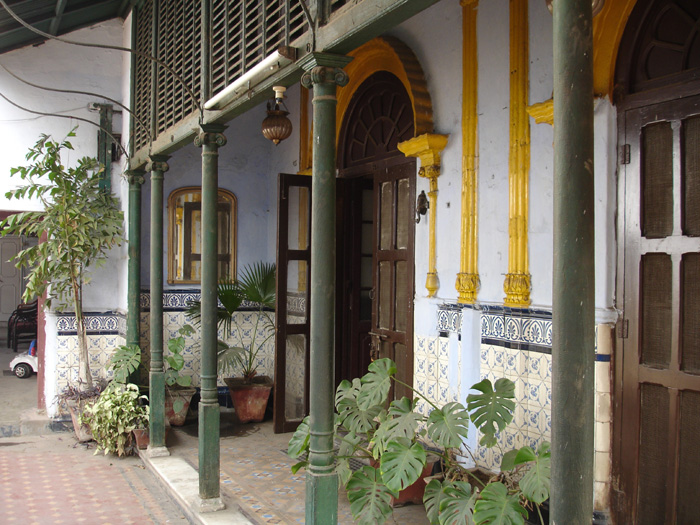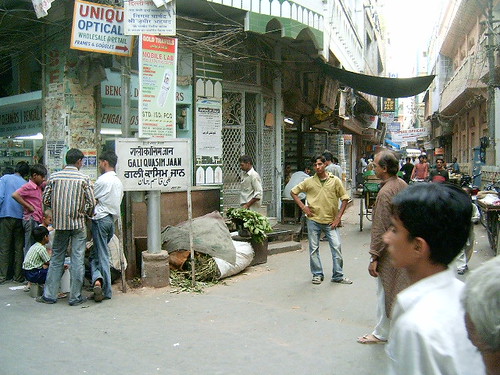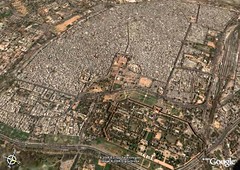
A straight walk into Chandni Chowk led us to Chunna Mal's Haveli on the right. Lala Chunna Mal was one of the wealthiest men in India during 1848, the time when he built his sprawling haveli. A banker, Lala Chunna Mal financed the railways in India. With 120 functioning rooms, and the ownership still with his descendants, the haveli is flourishing, though Chunna Mal was considered as a Brit-loving traitor...can't say much about that!

The haveli is a very famous landmark of Old Delhi, and has probably changed little since its construction..
The Ballimaran area is famous for its 'Hakim"s or doctors. The most famous alley here is called Galli Qasim Jaan. I will not call it the Stratford-upon-Avon of India, and draw a comparison between two unparalleled literary figures, Shakespeare and Mirza Ghalib.
 That's right. Mirza Ghalib lived and died in the alley you see above. It is crowded to bursting point most of the time, yet the rickshaw drivers display remarkable good-naturedness. If you get in their way, instead of the usual 'Get out of my way' that you'd hear anywhere in Delhi, here they say 'Badhte chalo, badhte chalo' which means 'Go forth, go forth'.
That's right. Mirza Ghalib lived and died in the alley you see above. It is crowded to bursting point most of the time, yet the rickshaw drivers display remarkable good-naturedness. If you get in their way, instead of the usual 'Get out of my way' that you'd hear anywhere in Delhi, here they say 'Badhte chalo, badhte chalo' which means 'Go forth, go forth'.
The home of the great Ghalib was treated foully till just a few years ago, an STD booth and a public urinal being run here till the Archaeological Survey of India protested. Ghalib always had one sadness in life, which was his not becoming the court poet, Zauq occupying the coveted post. Ghalib also pined away for his children, all 13 of whom died without crossing the age of 2. However, Ghalib loved his city, which was a cultural center, with all night music performances being held here (called mushaayras). The haveli is made using thin, dense Lakhori bricks and thick Deccan bricks, which are held together by mortar. Cement was not used at all, and the building is completely earthquake-resistant.

An interesting incident once occurred here during Ghalib's lifetime. Ghalib's neighbors were all mango-haters, and Ghalib loved mangoes more than any other fruit. Ghalib was sitting in his yard eating piles of mangoes with his neighbos trying to convince him that it wasn't such a good fruit after all. A donkey ambled by. Ghalib held out a mango as an offer to the donkey. The donkey sniffed it and walked away in disdain. At this, Ghalib's neighbors burst out laughing and said:
"Dekhiye, gadhay bhi aam nahin khate!" ("Even donkeys dont fancy mangoes!")
at which Ghalib promptly replied:
"Gadhay hee aam nahin khate!" ("Donkeys alone don't fancy mangoes!")
CONTD...as Part-III 'The Spiritual Lap of the Journey'...
Part-III to be up by tomorrow.



